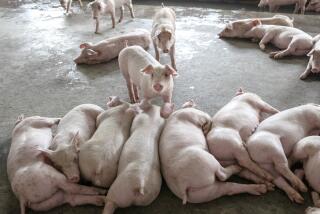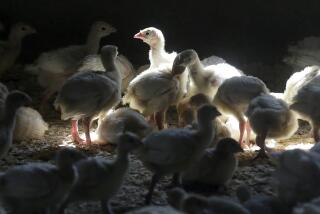Vaccine looks likely for H1N1 strains of swine flu
An analysis of more than 50 strains of the H1N1 influenza virus at the center of the global outbreak has concluded that they are closely related and can be fought with a single vaccine.
“We see much less variation among these new H1N1 viruses than we do for typical seasonal influenza viruses,” said Nancy Cox, senior author of a study released Friday by the journal Science. That will make the job of creating a pandemic flu vaccine “much, much easier,” she said.
Cox, who heads the influenza division at the Centers for Disease Control and Prevention in Atlanta, and colleagues from the U.S., Mexico and England also found that exposure to the normal seasonal flu strains provides little protection against the novel H1N1 that was identified in April.
Those findings could boost the likelihood that the U.S. will move forward with an H1N1 vaccine that would be offered separately from the seasonal flu vaccine.
The CDC is testing two potential seed stock candidates for an H1N1 vaccine to see whether they provoke an effective immune response.
The candidates combine portions of the H1N1 strain with other flu viruses that are known to grow efficiently in eggs, a key step in the vaccine-making process, said Dr. Anne Schuchat, interim deputy director for the CDC’s Science and Public Health Program.
The agency expects to deliver a suitable seed stock to vaccine manufacturers by the end of the month, Schuchat said Friday.
In a related development, the Department of Health and Human Services announced Friday that it had set aside approximately $1 billion for development of an H1N1 vaccine. Some of the money will fund clinical trials of a vaccine over the summer, and some will be used to ramp up production of key vaccine ingredients in case they are needed, said Health Secretary Kathleen Sebelius.
The CDC has identified 6,552 cases of confirmed and probable H1N1 flu in the U.S., including nine deaths. For each patient identified, public health officials estimate an additional 20 people have mild symptoms. “We’re estimating more than 100,000 people probably have this virus now in the U.S.,” Schuchat said.
Worldwide, there have been 11,168 cases in 42 countries, including 86 deaths, the World Health Organization reported Friday.
The report in Science traced the origin of all eight genes that make up the H1N1 virus and found that in each case, the closest known relative is from a swine flu. That suggests that the virus had been circulating among pigs for some time before recently jumping to humans.
However, scientists have yet to find this particular strain of H1N1 in any pig outside of Alberta, Canada, where an infected farmworker transferred the virus to a herd.
The study reinforces “the global need for increased surveillance of swine influenza in pigs,” Cox said. There are gaps in the way farm animals are monitored in the U.S., and surveillance efforts in other parts of the world are “much more limited,” she said.
The research team scrutinized the H1 gene, which codes for a protein called hemagglutinin, for molecular features that help a flu virus spread from person to person and make its victims sick. But they didn’t find any of the signatures associated with notoriously pathogenic strains, such as the 1918 Spanish flu and the H5N1 bird flu, according to the study.
Meanwhile, WHO Director-General Dr. Margaret Chan said Friday that she would reconsider the criteria used to declare a global flu pandemic.
The agency’s six-level infectious disease alert system now defines a pandemic as an instance of sustained human-to-human transmission in more than one geographic region. The emergence of 294 cases in Japan, combined with the continuing outbreak in North America, would seem to fit that definition.
But delegates to the annual World Health Assembly in Geneva this week pressed Chan to consider the severity of the virus and other factors before raising the alert to Phase 6. As the meeting wrapped up Friday, the level remained at Phase 5.
--







